Top News
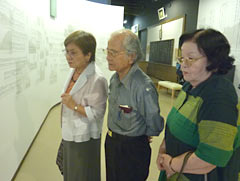
August 22, 2012 Eriko Tamaki, Ryukyu Shimpo
August 22 marked the 68th anniversary of the tragedy of the unmarked passenger-cargo ship Tsushima-maru being sunk by the submarine USS Bowfin on its way to Kyushu carrying hundreds of school children. The Tsushima-maru Memorial Museum engraves newly identified victims’ names every year, and this year has added seven names to the victim’s name panel. Among them, Kiyoko Omine’s name was included. This came about because her classmates who survived requested it in her memory.
Seventy-nine year-old Kazuko Onaga was one of those classmates who asked to have Kiyoko’s name added to the list. Kazuko was with Kiyoko when they applied to be evacuated on the Tsushima-maru in August 1944. Kazuko’s family did not approve and in the end she went on a different ship with her family. When Kazuko returned to Okinawa after the war she met Kiyoko’s mother, but she did not mention what happened to her daughter.
In order to find out whether or not Kiyoko was on board the ship when it was sunk, the museum staff and one of her old classmates, Shoichi Tokeshi tried to gather information from other survivors. It was difficult work to trace back through 68 years of memory, but Take Arakaki recalled that Kiyoko had in fact been on the Tsushima-maru. Take remembers that the day before the ship departed she visited Kiyoko’s house with her grandmother. Kiyoko was a bright student who was good at all sports. She played a major role in school play every year, was cheerful and well liked by the other students. Kiyoko’s mother told Take that she would send her daughter to the main islands of Japan because Kiyoko’s friends had said that they would not go if her daughter did not join them on the ship.
After the museum decided to add Kiyoko’s name, Kazuko and Take commented that they can imagine Kiyo-chan’s smile. Tokeshi said, “Victims would want their names to be added with those of their friends. I want to do more research because there will possibly be more names to add.”
The Tsushima-maru Museum compiles the victims list based on the applications for bereaved family pensions, as well as checking it against the names inscribed in the Cornerstones of Peace at Mabuni. Some names could be missing because there are no survivors in the family or because a pension application has not been submitted for some reason. Kuniko Hokama, the executive director of the museum, commented, “The children who died had their dreams and hopes destroyed in the blink of an eye. My wish is at least to have their names all engraved with those of their friends.”
(English translation by T&CT, Kyoko Tadaoka and Mark Ealey)
Go to Japanese
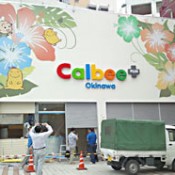
August 24, 2012 Ryukyu Shimpo
On August 28, major Japanese snack food maker Calbee opened its first shop, called the Okinawa Kokusai-Dori Calbee Plus, in the busiest street of Naha. Unlike other retail stores, the shop is popular because items are cooked then and there, in front of the customers. The Naha shop menu includes the potato snack jagarico, and beni-imo or sweet potato, which is only available in Okinawa.
The Kokusai-Dori shop is the fifth Calbee Plus, and the first one in Japan to be located on a main street. It is open seven days a week from 10:00am to 9:00pm. Pizza potato croquettes and the potato snack usushioaji, which tastes similar to Calbee’s popular pizza potato, are also sold only in Okinawa. It also has local products such as chinsuko and Ishigaki no shio on display in Calbee store for the first time.

On August 23, at the Okinawa Prefectural Government Office, on the occasion of the opening of the Kokusai-dori shop, Calbee media-relations representative Sayuri Tagawa talked about snack food items only available locally.
The company aims to attract 1000 customers a day to the Kokusai-dori shop, which is the same figure as for the Harajuku Takeshita-dori shop. It plans to increase the number of such stores to 12 or 13 by the end of fiscal 2015. The
Okinawa store employs about 20 workers, who are mainly local people.
Sayuri Tagawa, the Calbee media-relations representative, said, “We decided to open this shop in Okinawa in the hope that many tourists and locals will visit it and enjoy the snacks that it sells.”
(English translation by T&CT, Mark Ealey)
Go to Japanese
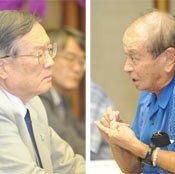
August 30, 2012 Ryukyu Shimpo
On August 29, Defense Minister Satoshi Morimoto visited Okinawa to report on the results of the investigation into the crash of an MV-22 Osprey that occurred in Morocco this April. During his stay he met with Okinawa Governor Hirokazu Nakaima, Ginowan Mayor Atsushi Sakima and the heads of the municipalities affected by the Osprey’s proposed flight routes. Although Morimoto stated that there is no problem with the aircraft itself, Nakaima opposed the deployment of the Osprey to U.S. Marine Corps Futenma Air Station, stating, “We cannot say that the Okinawa Prefectural Government will accept the deployment plan until the U.S. government resolves the safety issues around this aircraft.” Sakima again demanded that the plan to deploy the aircraft be cancelled, saying, “I have to oppose the plan. I want the U.S. and Japanese governments to reconsider it for the sake of the safety of more than 94000 citizens.” The heads of the municipalities strongly criticized the Japanese government, saying that the submission of the crash investigation results is designed to create a pretext for the deployment of the Osprey.
Nakaima talked to the media after meeting Morimoto, saying, “It is unacceptable to say that the Osprey is a safe aircraft because the problems were caused by human error.” When asked if he will attend the rally to protest against Osprey deployment that is scheduled to be held on September 9, Nakaima did not commit himself, saying, “I need a bit more time on that.”
In the meeting at the Okinawa Prefectural Office, Morimoto said that the team of experts sent to the United States by the Japanese government attributed the cause of the Osprey accident to an error by the copilot. Morimoto said that the Japanese government deplored the sexual assault resulting in injury caused by an U.S. Marine and demanded to the Okinawa Area Coordinator’s Office of U.S. Forces that strict discipline be enforced among its personnel.
Nakaima asked the Japanese government to provide a thorough confirmation of the safety of the Osprey, saying, “Our concerns over the aircraft will be assuaged if the Japanese government can clearly indicate the cause of the accidents and make Okinawan people understand that the Osprey is safe.”
After the meeting, Morimoto also talked to the media. He said, “I took particular note of what the governor said. I will talk to the Foreign Minister and Prime Minister about confirmation of safety issues. Morimoto denied the report stating that the Japanese and U.S. governments plan to deploy the Osprey to Futenma Air Station in the middle of September, saying, “If you define the word ‘deployment’ as the state in which the unit is ready to undertake its mission, then the Osprey will not be deployed to Futenma by the middle of next month. I do not recall the Japanese government making such a promise to the U.S. government.” However, Morimoto maintained an attitude of proceeding with consultation with his U.S. counterpart on the premise of the deployment of the Osprey to the base, saying, “We will aim to ensure safety of the aircraft through consultation between the Japanese and U.S. governments.”
That night, Morimoto boarded a Self-Defense Forces aircraft bound for Yamaguchi Prefecture, where the Osprey aircraft are currently located.
(English translation by T&CT, Mark Ealey)
Go to Japanese

August 21, 2012 Ryukyu Shimpo
On August 19, a traditional ceremony called miruku unke was held at Shuri Akata-cho, Naha. A smiling maitreya and his followers walked around the community and prayed for residents’ good health.
The miruku unke ceremony was revived in 1994 after not being held for about sixty years. Since then it has become an annual event, and this year is the 19th occasion that the ceremony has been held during the contemporary period. Starting from the Akata Club Community Center, the miruku advanced slowly, covering just 1.1 kilometers in one hour. A miruku walked at the head of what is called a sunei parade of about 100 people including a street marching band and children carrying the typical centipede flags of the Ryukyu dynasty. The band played Akata sundunchi on a wind instrument known as a pirarura. The miruku waved a paper fan to drive off evil spirits from around the people waiting to watch the parade. Some babies started crying and elderly people waved to the miruku from the second floor of their houses.
The 24 members of the marching band practiced for about two months in preparation for the parade. Kanko Teruya, the chairperson of Miruku Unke Planning Committee said, “So many people were interested in the parade that we did not have enough costumes, so we had to order some new ones. High school and junior high school students play a key role in the ceremony. It has helped to reconnect people in the community.” A dedication performance called an utuimuchi was held and students danced and performed karate.
(English translation by T&CT, Megumi Chibana and Mark Ealey)
Go to Japanese
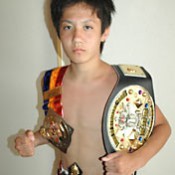
August 22, 2012 Ryukyu Shimpo
Fourteen year-old kick boxer, Kaito Gibu, a second grade pupil of Nago Municipal Omiya Junior High School, secured his third title in a competition held in Tokyo.
Gibu intends to fight in various competitions in future, saying, “I am determined to win all my bouts.”
He became champion in the 45-kilogram division in a competition sponsored by a Thai company. At the start of the fight, Gibu was on defensive, but he got the upper hand from the middle of the fight, going on to win on points.
In addition to this champion belt, Gibu won two championships at 40-kilogram division in other competitions in 2011. In recognition of his achievements, a Muay Thai promoter in Thailand plans to issue him with a Muay Thai fighter license, so young Gibu will become a professional Muay Thai fighter within the next year.
Gibu is currently practicing at a fight gym in Tokyo where kickboxing competitions are held. He comes back to Okinawa after each of his fights. He runs six kilometers in the morning and at night, and practices for several hours at the gym.
Gibu said, “I felt strong because I have been through a hard training regime. I aim to continue winning all the competitions this year.”
(English translation by T&CT, Mark Ealey)
Go to Japanese
August 18, 2012 Ryukyu Shimpo
Jetstar Hong Kong, an affiliated airline of the low-cost carrier Jetstar, is planning to launch a Naha-Hong Kong service. On August 17, Tsuyoshi Ichino, head of the public relations department for Jetstar Japan, said that the company plans to operate flights between Naha and Hong Kong, but he did not comment about the timing of the new service.
In March 2012, Jetstar Hong Kong was established after Jetstar and China Eastern Airlines set up a partnership, and will start operating in 2013.
Meanwhile, Jetstar Japan is planning to increase the number of flights on popular routes such as Naha-Haneda. Currently, there are two round-trips, so four flights a day between these two airports. Popular flights to Naha and Chitose in Hokkaido have attracted more passengers than expected and are almost full.
Within the next three years, Jetstar Japan is planning to increase the number of flights using the Airbus A320, which can carry 180 people, from the current four to 24 flights. They are also considering opening new routes in addition to the existing six routes including Narita-Naha and Kansai-Naha.
(English translation by T&CT, Megumi Chibana and Mark Ealey)
Go to Japanese
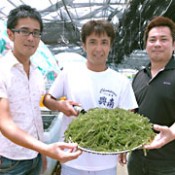
August 22, 2012 Ryo Akamine of Ryukyu Shimpo
Seeking to establish a stable production and sales structure for sea grapes produced in Okinawa, in mid-September the Sea Grapes Producers Council, which is made up of 140 individuals and organizations involved in the production of sea grapes, will make sea grapes into a brand. This will be done by attaching a sticker to the packaging that specifies the area of production and the quality of the product. The council will carefully select marketable sea grapes that are ripe for eating and firm. To add momentum to promotion activities, from August new members joined the council to officially work on this project.
The council will box sea grapes at facilities that have passed Okinawa Prefectural Government food hygiene inspections, and establish safety standards such as regularly checking for the spread of bacteria. The council aims to set a stable price and to expand the market by making safe and high-quality sea grapes produced in Okinawa into a brand.
The council was scheduled to sell certified products from last April but that was postponed. It started the projects up again because the sales volume of sea grapes has remained restrained despite production increasing year by year. Sea grapes produced in Okinawa are popular in the main islands of Japan, but those from the Philippines have started to become available to consumers at Tsukiji Fish Market in Tokyo. The council wants to highlight the difference between the origin of the sea grapes by turning those produced in Okinawa into a brand.
According to information gleaned from a questionnaire submitted to members of the council, production volume of sea grapes increased from 213 tons to 280 tons during the period from 2006 to 2010. At the same time, the price dropped from about 300 yen per 100 grams to about 230 yen.
Kazuya Oshiro, the executive director of the council said, “I want information to be shared among the members. The council aims to protect the livelihood of the producers of sea grapes by buying products from individual producers, and selling them at a stable price.” Oshiro went on to say, “We are considering expanding the market to the prefectures that are not so familiar with Okinawa. We are trying to move beyond the Tokyo metropolitan area, where sea grapes produced in Okinawa are already available. We also want to do our bit to add vitality to Okinawan tourism.”
(English translation by T&CT, Mark Ealey)
Go to Japanese
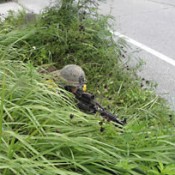
August 15, 2012 Naoki Isa of Ryukyu Shimpo
On August 11 at Katabaru, Matsuda Ward, Ginoza, four U.S. soldiers were seen lying in the grass on the roadside pointed their weapons toward the road. They were likely taking aim at amphibious vehicles crossing Route 329 from the shore and moving towards Camp Hansen. According to the Northern National Roads Office that area of the sidewalk is not within U.S. facilities.
Nago Municipal Assembly member Takahito Oshiro witnessed the scene. He said that the soldiers took up positions at four points on the sidewalk and pointed their guns at the road when seven amphibious vehicles crossed Route 329.
He explained that the vehicles had landed on the coast of Katabaru from Camp Schwab and went into Camp Hansen. They damaged part of the curb when they crossed the road.
(English translation by T&CT, Megumi Chibana and Mark Ealey)
Go to Japanese
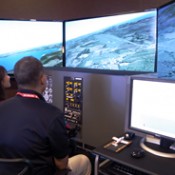
August 18, 2012 Ryukyu Shimpo
This month Flight Simulation Okinawa (FSO), which is based in Chatan, has started a new pilot training program using an aircraft simulator. The company said that the machine was the only simulator in Japan designated by the governments of Japan and the United States. The actual flights that have been conducted in the United States will also be carried out in Okinawa this autumn. It will become possible to complete all of the training courses in Okinawa that are required to get a pilot license for small aircraft. The company has a business plan in which people enjoy tourism and at the same time gain a pilot’s license in Okinawa. They will promote it to attract students from outside Okinawa.
On August 17, the company held a preview session at the Beach Tower Okinawa in Chatan. This is the first facility available to the students in a resort hotel in Japan. The Okinawa Prefectural Government has approved the FSO’s business plan within its management innovation support project.
The FSO aims to set up a company by this August. It has continued training for three years since the Federal Aviation Administration approved the aircraft simulator. In late July, the Civil Aviation Bureau of the Japanese Ministry of Land, Infrastructure, Transport and Tourism (MLIT) granted approval for the FSO the highest level 3 for the small aircraft simulator. The student is required to operate an airplane in the United States in order to complete all courses for the license. With the certification issued by the MLIT, the FSO will provide all of the flight training in Japan required to get the pilot license. Commercial and private pilots need to renew their qualifications every two years due to the Civil Aeronautics Law being revised in April 2012. Naoya Tamanaha, the head of FSO, said that it will allow tourists who are able to update the license while enjoying Okinawa with their family. In addition to a pilot license for visual flight, it will be possible to gain a qualification of instrument flight certification to operate with instructions from aircraft controllers. Training simulator shortens the actual flight-training period and it reduces the cost to one third of that for actual flight-training.
Tamanaha, chief instructor and examiner of the Kadena Aero Club for a social welfare program run in Kadena Air Base, explained that there had been a time when it had been very difficult to become a professional pilot, and said, “ I want to promote this business as much as I can, reducing the high cost of obtaining instrument flight certification.”
(English translation by T&CT, Lima Tokumori and Mark Ealey)
Go to Japanese

August 24, 2012 Ryukyu Shimpo
The Philippine Nikkei-jin Legal Support Center is seeking information about Minoru Uechi and his son Mitsunari who may know Hiroshi, the father of Yoneko Arakaki, whose Filipino name is Inocencia. Yoneko visited Okinawa last summer.
Minoru was born in 1927 in Davao Santa Cruz, in the Philippines, as the son of father Kamasuke and mother Salvadora. Kamasuke is Yoneko’s father’s cousin.
After World War II Minoru moved to Okinawa, his father’s homeland, and during the 70s he sent letters with pictures to his relatives back in the Philippines. Some family photographs exist of his wife Tomiko and their son Mitsunari when he was six years old.
A letter suggests that his address was “87 Zakimi, Yomitan Village,” but that has not been confirmed. Minoru met Yoneko in Davao around 1972 or 1973.
Minoru’s father Kamasuke was repatriated to Japan after the war, but it would seem that he did not enter his presence on his family registry in Yomitan, which had been his official domicile before the war.

Mitsunari, the son of Minoru Uechi, would be in his 40s.
If alive, Minoru would now be 85 years old, and his son Mitsunari would be in his 40s. Yoneko has applied to create a new family register under her Japanese nationality and the Philippine Nikkei-jin Legal Support Center requests information about them because Minoru would be able to testify that Yoneko is a Japanese descendant. The contact phone number is 03 (3355) 8861.
(English translation by T&CT, Kyoko Tadaoka and Mark Ealey)
Go to Japanese

August 22, 2012 Ryukyu Shimpo
Disabled people have placed a red handkerchief banner on the roof of the Aitopia at Yonashiro, Uruma. U.S. aircraft fly over the welfare service facility in which they work, during routine operations between the air base and training areas such as Ukibaru and Tsuken. The people sent an angry message to the U.S. forces and set up the red banner on the roof, when the Okinawa people’s rally on August 5 was postponed. The red banner is made of about 100 separate handkerchiefs.
They wrote characters and symbols on the red handkerchiefs to express their anger and placed lines crossing on the red cloth on the roof to indicate a cross to U.S. military aircrews. One of the people said, “We want to show the Okinawan people’s burning anger by putting the red cloth on the roof.”
Mitsue Tomiyama, the manager of the facility, said, “Disabled people suffer the most in an emergency such as a natural disaster or an accident. As citizens of Okinawa, they too should think about the Osprey deployment and express their thoughts.”
(English translation by T&CT, Mark Ealey)
Go to Japanese












 Webcam(Kokusai Street)
Webcam(Kokusai Street)


